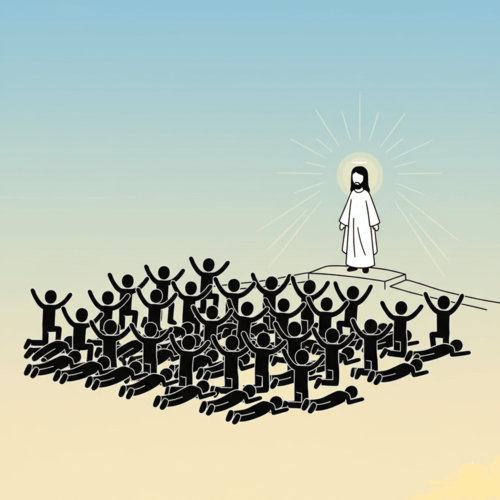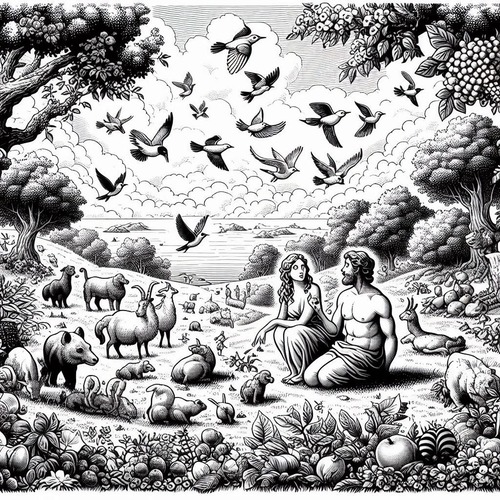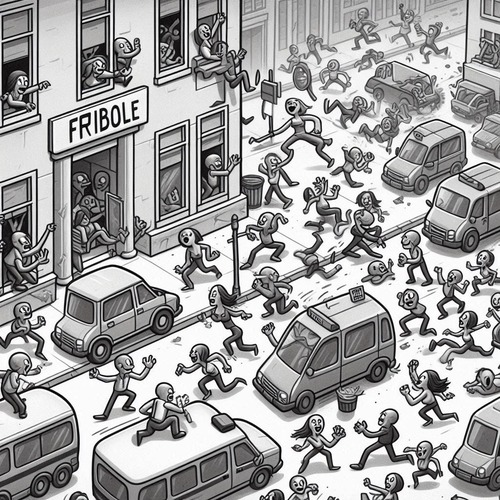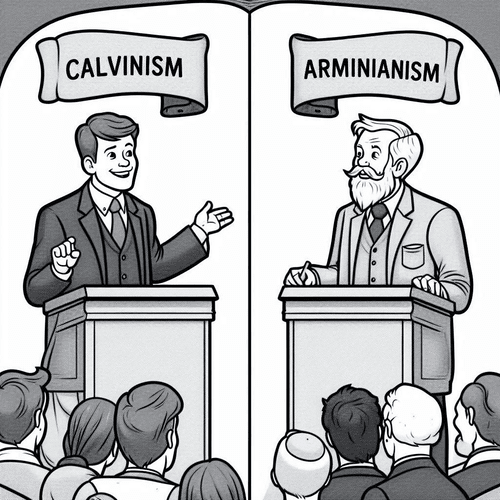Genesis 1 and 2 Accounts: Reconciling Apparent Contradictions
The Genesis 1 and 2 accounts of creation have long sparked debate, especially with sceptics claiming these chapters contradict each other. The seeming discrepancies between Genesis 1 and 2 lead to questions about the consistency of these foundational texts. How can Christians reconcile these differences? This article delves into these apparent contradictions, offering perspectives that harmonise the creation narratives and deepen our understanding of Biblical interpretation.
Overview of the Genesis 1 and 2 Accounts
Genesis 1 and Genesis 2 offer two different perspectives on creation. Genesis 1 provides a structured, day-by-day account of how God created the world in six days, focusing on the cosmic order. The focus is on the majesty and power of God (referred to in Genesis 1 as Elohim), who speaks creation into existence.
Genesis 2, on the other hand, zooms in on the creation of Adam and Eve and their immediate environment in the Garden of Eden. It focuses on God’s (referred to here as Yahweh Elohim) intimate involvement with creation and His relationship with man and woman. This account emphasises the relational aspects of creation, highlighting the special role human beings play as image-bearers of God.
Together, these chapters provide complementary narratives, offering both a cosmic and intimate view of creation.
Addressing Apparent Contradictions Between the Genesis 1 and 2 Accounts
1. Chronological Order of Creation
Apparent Contradiction: Genesis 1 details the creation of plants, animals, and Adam and Eve in a specific order over six days. Genesis 2 seems to suggest man was created before plants and animals.
Explanation: The key to resolving this is understanding the different purposes of Genesis 1 and 2. Genesis 1 provides a chronological, structured account of creation over six days, describing the general order of creation events. Genesis 2 is not a conflicting chronological retelling but a zoomed-in view of the creation of humanity and their environment in the Garden of Eden. The focus is on the relationship between human beings, God, and the created world. The order in Genesis 2 is thematic, not chronological, emphasising humanity’s central role in creation.
2. Creation of Vegetation
Apparent Contradiction: Genesis 1 says God created vegetation on Day 3, while Genesis 2:5-7 seems to suggest no plants had yet appeared because there was no rain and no man to cultivate the ground.
Explanation: Genesis 2 refers specifically to cultivated plants or “shrubs of the field” that require human labour. Genesis 1 speaks about the creation of all vegetation—trees, grass, plants—on the third day. The “shrubs of the field” mentioned in Genesis 2:5 are a different category of plants that would need human tending, like crops and fields. These are described as not yet being present in the garden because Adam, the gardener, had not yet been formed. Genesis 1 offers a global perspective, while Genesis 2 focuses on the local and specific conditions in the Garden of Eden.
3. Creation of Animals
Apparent Contradiction: Genesis 1 states animals were created before human beings on Days 5 and 6, but Genesis 2:19 seems to suggest animals were created after Adam.
Explanation: The seeming contradiction arises from a misunderstanding of the verb tense in Genesis 2:19. The verb “formed” can be translated as “had formed,” indicating that God had already created the animals before bringing them to Adam. Genesis 2:19-20 focuses on Adam naming the animals, a task given to him after they were already created. This emphasises Adam’s dominion over the animals, as described in Genesis 1, rather than presenting a new or conflicting timeline of their creation.
4. Creation of Man and Woman
Apparent Contradiction: Genesis 1:27 seems to present man and woman as created simultaneously, while Genesis 2:7 and 2:21-22 show Adam being created first, followed by Eve being formed from his rib.
Explanation: Genesis 1:27 offers a summary statement that both man and woman were created in God’s image, but does not detail the process. Genesis 2, on the other hand, gives the specific details of how they were created, starting with Adam and then Eve. These accounts aren’t contradictory but complementary. Genesis 1 offers an overview, while Genesis 2 zooms in on the relational dynamics between man and woman. This account emphasises the covenantal relationship of marriage, where woman is made from man’s side to signify equality, unity, and partnership.
Theological Insights from the Genesis 1 and 2 Accounts
Rather than presenting contradictions, Genesis 1 and 2 offer two perspectives on creation that enrich our understanding of God’s work and humanity’s place in it. Genesis 1 presents God as the transcendent Creator of the universe, bringing order out of chaos through His powerful Word. Genesis 2, however, shows a more intimate picture of God, who forms man from the dust of the earth and breathes life into him.
These complementary accounts underscore the special role of humanity in creation. Man and woman aren’t simply part of creation but are set apart as image-bearers of God, called to steward and care for creation. The relational nature of creation is also emphasized, particularly in the creation of woman from man, which highlights the covenantal and communal aspects of human existence. Marriage, work, and worship are foundational themes that flow from these chapters, providing a framework for human life that reflects God’s design.
Conclusion: Are the Genesis 1 and 2 Accounts Contradictory?
When properly understood, Genesis 1 and 2 aren’t contradictory but complementary. Genesis 1 provides the overarching account of creation, focusing on the ordered structure and grandeur of the universe. Genesis 2 offers a close-up view of humanity’s creation and the relational dynamics between humans and their environment.
These two chapters work together to present a unified message: God is the Creator of all things, and humans hold a unique and special role as His image-bearers. The focus of Genesis 1 is the order of creation, while the focus of Genesis 2 is the special relationship between God and humanity. Together, they provide a profound understanding of the nature of creation, humanity’s purpose, and the covenantal relationships that define human life.
By recognising the different purposes of these chapters, we see there aren’t any real contradictions—only different perspectives that together enrich our understanding of the creation accounts.
Related FAQs:
- How do the different divine names in Genesis 1 and 2 contribute to our understanding of the creation narrative? The use of distinct divine names—”Elohim” in Genesis 1 and “Yahweh Elohim” in Genesis 2—plays a crucial role in the Genesis creation accounts. In Genesis 1, “Elohim” highlights God’s transcendent power and majesty, fitting the grand, cosmic scope of creation. In Genesis 2, “Yahweh Elohim” emphasises God’s personal, covenant relationship with humanity, aligning with the intimate focus on Adam, Eve, and the creation of humans. This variation helps harmonise the Genesis 1 and 2 creation stories, revealing both God’s universal authority and His close involvement with humanity.
- Which person of the Trinity was primarily involved in the act of creation according to Genesis? Though Genesis does not explicitly describe the Trinity, hints of God’s triune nature appear in the creation accounts. Genesis 1:1-2 mentions God (traditionally linked with the Father) and the Spirit of God. The New Testament further illuminates this by revealing Jesus’ role in creation (John 1:1-3, Colossians 1:16), allowing us to retroactively see the Trinity at work in Genesis. Christian theology views the act of creation as a unified effort of the Trinity, with the Father as the source, the Son as the agent, and the Spirit as the one who brings life and order. Thus, the entire Trinity is involved in creation according to a holistic interpretation of Genesis 1 and 2.
- Where can we identify Trinitarian concepts in the early chapters of Genesis? While the doctrine of the Trinity is not explicitly stated in Genesis 1 and 2, several elements hint at it. For example, the plural pronouns in Genesis 1:26 (“Let us make man in our image”) suggest a conversation within the Godhead, often interpreted as an early reference to the Trinity. The mention of the Spirit of God in Genesis 1:2 is seen as a hint of the Holy Spirit’s role in creation. Additionally, the New Testament’s revelation of Christ’s role in creation (John 1:1-3) informs a retroactive Trinitarian understanding of Genesis. These references suggest that while the Trinity is not fully revealed in Genesis, its presence is implicit and becomes clearer in light of later biblical texts.
- How do scholars reconcile the apparent differences in the creation order between Genesis 1 and 2? Scholars explain the differences between the creation order in Genesis 1 and 2 by recognizing the distinct literary styles and purposes of each chapter. Genesis 1 presents a broad, structured chronology of creation, while Genesis 2 offers a more focused account, emphasizing the relationship between humans, their environment, and their Creator. Genesis 2 is not meant to be a strict chronological sequence but rather a thematic exploration of humanity’s creation. When viewed together, the two creation stories in Genesis are complementary rather than contradictory, each contributing to a fuller understanding of the creation narrative.
- What is the most compelling response to critics who claim the harmonisations of Genesis 1 and 2 are contrived or unsatisfactory? The most compelling response to critics of Genesis harmonisation is to emphasise the importance of understanding ancient Near Eastern literary conventions and the specific purposes of each creation account. Genesis 1 and 2 employ different literary styles and focus on distinct aspects of creation, which explains their apparent differences. Rather than being contrived, careful harmonisation takes into account the cultural and literary context of the original text, as well as the theological intentions of the author. This approach demonstrates the creation accounts are complementary, not contradictory, each serving a unique purpose in conveying the creation narrative. Moreover, it’s worth noting ancient readers likely didn’t perceive these accounts as contradictory, suggesting that modern perceptions of conflict may stem from misunderstanding the text’s original context and purpose.
Our Related Posts
- Bible ‘Contradictions’: Not Quite Hurdles to Faith
- Creation or Evolution: Let the Evidence Speak for Itself
- Defending Creationism: Responses to Evolutionists
- Beyond Chance: Exploring the Scientific Case for Creation
Editor's Pick

‘Flee Sexual Sin’: Why Does Paul Single This Sin Out?
When the apostle Paul writes to the Corinthian church, he doesn’t tell them to simply avoid sexual immorality or resist [...]

Does Denying God’s Sovereignty Mean Denying the Gospel?
RC Sproul once warned denying God’s sovereignty “eviscerates” grace—a strong word meaning to gut or disembowel something, leaving only an [...]

Why Christians Fast: The Biblical Discipline’s Very Real Rewards
Why would Christians, who rejoice in the good gifts of food and fellowship, deliberately choose to go without? Isn’t fasting [...]

The Christian Sabbath: Why Did Sunday Replace Saturday?
Consider this: God-fearing Jews who’d faithfully observed Saturday Sabbath for over a thousand years suddenly began gathering for worship on [...]

Did the Early Christians Worship Jesus? The Biblical Evidence
It was a startling transformation: Jewish fishermen who'd spent three years following this itinerant carpenter from Nazareth now begin to [...]

If Jesus is Messiah, Why Aren’t ALL Messianic Prophecies Fulfilled?
If Jesus is truly the Messiah, why hasn't world peace arrived? Why do Jews still face persecution? Why isn't the [...]

When Courage Fails: Will I Be Forgiven If I Deny Christ in Persecution?
The rooster crowed, and Peter remembered. In that devastating moment, the apostle realised he’d just done the unthinkable—three times he’d [...]

What Makes a Godly Dad? 5 Biblical Principles Fathers Need
Modern culture sends fathers mixed messages. Be strong but sensitive. Be involved but not overbearing. Lead but don’t dominate. With [...]

What Makes a Godly Mom? A Scripture-Backed Guide
In our culture’s confusion about gender roles and parenting, the timeless question remains: what makes a godly mother? While secular [...]

Paul’s Mandate for Men: Headship Or Servant Leadership? Or Both?
Modern Christianity has fallen into a trap. We've created an either/or battle between "headship" and "servant leadership," as if these [...]
SUPPORT US:
Feel the Holy Spirit's gentle nudge to partner with us?
Donate Online:
Account Name: TRUTHS TO DIE FOR FOUNDATION
Account Number: 10243565459
Bank IFSC: IDFB0043391
Bank Name: IDFC FIRST BANK






